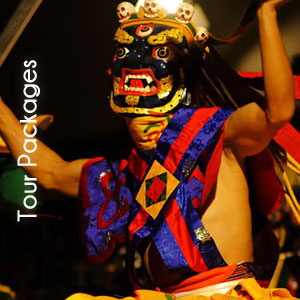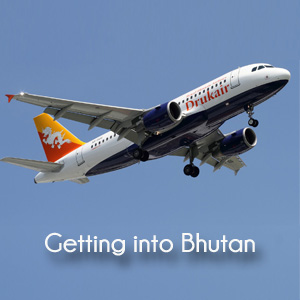National Emblem
The National Emblem of Bhutan is a circle that projects a double diamond thunderbolt placed above the lotus. There is a jewel on all sides with two dragons on vertical sides. The thunderbolts represent the harmony between secular and religious power while the lotus symbolizes purity. The jewel signifies the sovereign power while the dragons (male and female) stands for the name of the country Druk yul or the Land of the Dragon.
National Flag
The National flag is rectangle in shape that is divided into two parts diagonally. The upper yellow half signifies the secular power and authority of the king while the lower saffron-orange symbolizes the practice of religion and power of Buddhism, manifested in the tradition of Drukpa Kagyu. The dragon signifies the name and the purity of the country while the jewels in its claws stand for the wealth and perfection of the country.
National Flower
The national flower is Blue Poppy (Meconopsis Grandis). It is a delicate blue or purple tinged blossom with a white filament. It grows to a height of 1 meter, on the rocky mountain terrain found above the tree line of 3500-4500 meters. It was discovered in 1933 by a British Botanist, George Sherriff in a remote part of Sakteng in eastern Bhutan.
National Tree
The national tree is cypress (Cupressus torolusa). Cypresses are found in abundance and one may notice big cypresses near temples and monasteries. Cypress is found in the temperate climate zone, between 1800 and 3500 meters. Its capacity to survive on rugged harsh terrain is compared to bravery and simplicity.
National Bird
The national bird is the raven. It ornaments the royal crown. Raven represents the deity Gonpo Jarodongchen (raven headed Mahakala), one of the chief guardian deities of Bhutan.
National Animal

The national animal is the Takin (burdorcas taxicolor) that is associated with religious history and mythology. It is a very rare mammal with a thick neck and short muscular legs. It lives in groups and is found in places above 4000 meters high on the north-western and far north eastern parts of the country. They feed on bamboos. The adult takin can weigh over 200 kgs.
National language
Bhutan is a multi-lingual society. Today, about 18 languages and dialects are spoken all over the country. The state language is Dzongkha which in the olden times was spoken by people who worked in the Dzongs that was the seat of temporal and spiritual power. Later, Dzongkha was introduced as the national language of Bhutan.
National Anthem
The national anthem was first composed in 1953 and became official in 1966. It is known as Druk Tshenden Kepay Gyalkhab Na (In the land of the Dragon Kingdom, where cypress grows).
National Day
17th December is celebrated as the National Day of the country that coincides with the crowning ceremony of Gongsa Ugyen Wangchuck as the first hereditary king of Bhutan, in Punakha Dzong on 17 December 1907. It is a national holiday and every Bhutanese celebrates the day with pomp and festivity throughout the country.

Bhutan Travel Info
Bhutan Travel tips, Daily Tourist Tariff, Bhutan Visa Information, Tour payment regarding your tour booking to Bhutan. Click on the link below to know more.
Learn more >>

Tour Packages
Travel to Bhutan with Sachock Bhutan Travels. We, at Sachock offers Cultural tours, Trekking Tours including the World's toughest Trek Snowmen Trek and colorful Festival tours of Bhutan.
Learn more >>

Getting into Bhutan
Travelling to Bhutan can be accessible by Air, to Paro(the only international airport in Bhutan connecting with Indian Cities, Nepal, Bangaldesh, Thailand & Singapore) & Road through Southern border towns of Phuentsholing, Gelephug and Samdrup Jongkhar.
Learn more >>

Sachock Bhutan Travels, P.O Box No: 1304, Karma Khangzang, Thimphu : Bhutan
Phone # (+975) 77177717 / 77210443 : Tele-Fax (+975) 2 333 881
Email: [email protected] / www.SachockBhutanTravels.com
Sachock Bhutan Travels, Copyright © 2025. All Rights Reserved.






